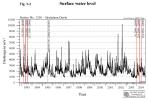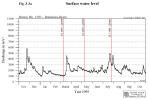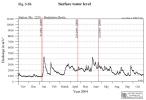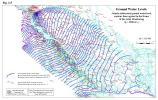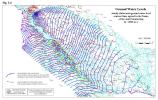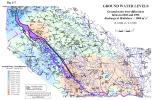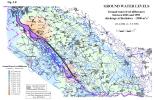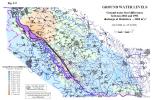PART 3
Ground Water RegimeThe impact of the temporary technical measures and discharges into the Danube and Mosoni branch of the Danube, realised according to the Agreement, and the impact of the water supply on the ground water regime and ground water levels in the hydrological year 2004 was monitored by 265 observation wells on the Slovak and the Hungarian territories. These monitoring objects are situated in the area of ®itný ostrov and in the Szigetköz region. List of observation wells is given in National Annual Reports from environmental monitoring respectively. The situation of the observation networks on both sides is shown in Fig. 3-1. The evaluation of ground water level data in 2004 in local scale was done by the Parties themselves and is given in National Annual Reports. The jointly elaborated regional evaluation given in this report was prepared according to the jointly constructed ground water level equipotential lines. The equipotential lines were constructed for comparison of the ground water levels in the influenced area in the current year and the ground water levels before construction of bottom weir and introducing the water supply into the river branches on the Hungarian side. 3.1. Joint evaluation of the ground water regimeThe groundwater levels in the observed area were primarily influenced by the surface water levels in the Danube and reservoir. Average and low water period in the second half of the hydrological year 2003 and low water period at the beginning of hydrological year 2004 significantly influenced the ground water levels in the whole area. The ground water levels decreased and on a greater part of the observed area (except the neighbourhood of the reservoir) reached the lowest or nearly lowest values since introducing the water supply. This decrease of water storage only slowly recovered. Average groundwater levels were reached from April after the surface water level increase. Highest water levels were induced after the flood wave in June. Since then the groundwater levels till the end of the hydrological year decreased again. Around the reservoir and in area influenced by water supply – in the Slovak and Hungarian river branch system and along the Mosoni Danube – the ground water level was raised. This evaluation is focused onto the area influenced by the water supply. The ground water level position depends mainly on the water level fluctuation in the Danube, water level position in the reservoir and water level fluctuation in river branches. For computing the ground water level differences three hydrological situations were chosen in the period before and after introducing the water supply. The hydrologic situations were selected to characterise the low, average and high flow rate conditions in the Danube, corresponding to flow rates approximately 1000, 2000 and 3000 m3s-1. The selected dates and the corresponding flow rates in the Danube at Bratislava-Devín gauging station are the following (Tab. 3-1, Fig. 3-2, Fig. 3-3a, Fig. 3-3b): Table 3-1
Low flow rates period in the hydrological year 2004 occurred in the winter period from the beginning of November 2003 till middle of January 2004. For the evaluation purposes the hydrological situation at the end of a period with low flow rates in January 2004 was chosen. The average flow rates period was chosen in the second half of April, in a comparable hydrological situation as the period chosen in 1993. The high flow rates period was chosen in the second half of June 2004. Maps of equipotential lines were jointly constructed for the selected dates using the measured ground water levels (Fig. 3-4, Fig. 3-5 and Fig. 3-6). In wells where the water level is measured once a week the ground water level for the selected dates were computed by linear interpolation. In the all other wells the daily average values were used. The altitudes of the ground water levels are given on maps for each observation object used for the equipotential line construction. For the equipotential lines construction computed surface water level data in the Danube were used as well. These levels were computed by calibrated model, using river morphology data and measured water level data on given stretch. The other surface water levels were not used for construction of the equipotential lines. The constructed equipotential lines represent general ground water levels and do not show local influences of the channels or river branch systems. Differences between ground water levels for selected comparable hydrological situations are expressed in Fig. 3-7, Fig. 3-8 and Fig. 3-9. The evaluation is mainly focused to the area influenced by the technical measures and discharges according to the intergovernmental Agreement and by the water supply realised on the Hungarian side. In this sense the inundation and the flood-protected area on the Hungarian side and partly the inundation area on the Slovak side represent the influenced area. Low flow rates conditions Comparing the low water hydrological situations (approximately 1000 m3s-1) in periods before and after realising the technical measures and releasing discharges according to the Agreement (2004 versus 1993) it can be stated, that in consequence of increased water level in the Danube old riverbed and water supply into the right side river branch system and into the Mosoni Danube, on whole part of influenced area significant increase of ground water levels occurred, both on the flood-protected area and inundation area as well (Fig. 3-7). However, due to unfavourable hydrologic situation in the second half of the hydrological year 2003 and at the beginning of the hydrological year 2004 the increase of ground water level was lower than in previous years. The ground water level increase in the upper part of the Szigetköz area between Rajka and Dunakiliti reached app. 0.3 m. In the middle part of the Szigetköz area between Dunakiliti and Ásványráró significantly higher ground water levels were created at low flow rate conditions. Significant increase of ground water level occurred also along the Mosoni Danube as well. In the lower part of the Szigetköz, downstream from Ásványráró and around the Bagoméri river branch system, where the water supply is still not solved, the ground water levels were lower than the ground water levels in 1993. Lower ground water levels were recorded at the whole lower part of the ®itný ostrov as well, due to the abovementioned unfavourable hydrologic conditions. The most significant decrease of ground water levels occurred along the tailrace channel and downstream the confluence of the tailrace channel and the Danube old riverbed. The riverbed erosion influences this region. In general the increase of ground water levels is about 0.2-1.2 m in comparison to ground water levels in 1993. It occurs mainly in the area affected by the water supply realised on the Hungarian side. There is increase of ground water levels in the inundation area on the Slovak side as well, which is evoked by the water supply on the Slovak side, however this is independent on the measures according to the Agreement. The ground water level fluctuation during the year in the upper and middle part of the Szigetköz region was around 0.5-1.5 m. In the lower part of the Szigetköz it changed between 1.5-3 m. Due to long-term low flow rates in the Danube the ground water level in observed wells approached the lowest or nearly lowest recorded levels. On the left side of reservoir a decrease of ground water levels can be observed. This is connected with lower water level in the reservoir comparing to the 1993 and decrease of permeability of the reservoir bottom as well. However, the ground water levels at present are much higher than before constructing the dam. The decrease of ground water levels downstream of the Gabčíkovo hydropower station is caused by partial deepening of the tailrace canal and erosion of the Danube riverbed downstream of the confluence (at mouthing of the Bagoméri river branch). However, the decrease in 2004 is more significant due to long-term low flow rates in the Danube. Average flow rate conditions Comparing the ground water levels in the period before realising the technical measures and after increasing the discharges into the Danube according to the Agreement and after introducing the water supply on the Hungarian side, at average flow rate conditions in the Danube (approximately 2000 m3s-1), the result is similar to that at low water conditions. In the upper part of the Szigetköz area, between Rajka and Dunakiliti only slight increase of ground water level can be observed due to unfavourable long-term low flow rate in the Danube. Significant increase of ground water levels occurred in the middle part of the Szigetköz area. The increase of ground water level is about 0.2-1 m (Fig. 3-8). The most significant ground water level in 2004 increase occurred in the upper and middle part of the Hungarian inundation area where it reaches 0.5-1.2 m. Comparing to the year 1993 the ground water levels along the Danube in the lower part of the Szigetköz (Bagoméri river branch system) were slightly lower and were influenced by the low flow rates in the Danube. The decrease of ground water levels is caused by riverbed erosion in this Danube stretch. On the Slovak territory no impact of the technical measures according to the Agreement appears. Higher ground water levels in the left side inundation area reflect the different water supply regime into the river branch system in 1993 and 2004. Decrease of ground water levels can be observed around the left side of the reservoir. This results from lower water level in the reservoir comparing to the 1993 and decrease of permeability of the reservoir bottom as well, but in general the ground water levels are higher than before damming the Danube. On a large part of the Slovak side there were no change in ground water levels observed. High flow rate conditions When comparing the high flow rate conditions in the Danube (approximately 3000 m3s-1) for the period before (1993) and after (2004) realising the measures according to the Agreement, decrease of ground water levels can be seen along the Danube, both in the Szigetköz and ®itný ostrov regions (Fig. 3-9). The decrease in the inundation area reaches 0.1-0.8 m. This difference is caused by the difference in the discharges released to the Danube old riverbed in 1993 (1020 m3s-1) and in 2004 (592 m3s-1). On a large part of the Szigetköz area there is increase of the ground water levels, which is partially caused by the water supply in the Mosoni Danube and partially by higher ground water levels on the examined area boundaries. Decrease of ground water levels on the left side of the reservoir are related to lower water level in the reservoir comparing to the 1993 and decrease of permeability of the reservoir bottom. In the middle part of the ®itný ostrov area no change is documented. The increase in the lower part of ®itný ostrov area is connected with higher water levels in the Malý Danube and in the channel system. 3.2. ConclusionsThe unfavourable hydrological conditions in the second half of hydrological year 2003 (low flow rates in the Danube) and at the beginning of hydrological year 2004 significantly influenced the ground water levels in the examined area. The ground water storage significantly decreased and during the year only slowly recovered. The ground water level on most of the observation wells reached the lowest or nearly lowest values since introducing the water supply. In general it can be stated that the water supply into the right side river branch system plays an important role in influencing ground water levels over the Szigetköz region. As a result of the measures realised according to the intergovernmental Agreement significant increase of ground water levels occurred for low and average flow rate conditions in the Danube. No changes in the upper and middle part of the Szigetköz region and decrease of ground water levels along the Danube riverbed can be registered for the high flow rate conditions. The monitoring results highlights the necessity of solving the ground water level decrease in the lower part of inundation area on both sides. The necessary ground water level increase in the lower part of the Ásványi river branch system, in the Bagoméri river branch systems and Istragov island on the Slovak side could be solved by extension of the water supply system to these areas or by measures applied in the Danube old river bed upstream of the confluence with the tailrace channel. Such measures can improve the situation in this region. Increase of ground water levels in the strip along the Danube old riverbed on both side could be ensured only by increasing water level in the Danube by measures realised in the riverbed. The most simple, quickly realisable measure seems to be the solution applied at Dunakiliti at rkm 1843, realised according to the “Agreement”.
|
|||||||||||||||||||||||||

